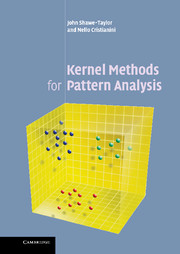Book contents
- Frontmatter
- Contents
- List of code fragments
- Preface
- Part I Basic concepts
- 1 Pattern analysis
- 2 Kernel methods: an overview
- 3 Properties of kernels
- 4 Detecting stable patterns
- Part II Pattern analysis algorithms
- Part III Constructing kernels
- Appendix A Proofs omitted from the main text
- Appendix B Notational conventions
- Appendix C List of pattern analysis methods
- Appendix D List of kernels
- References
- Index
1 - Pattern analysis
from Part I - Basic concepts
Published online by Cambridge University Press: 29 March 2011
- Frontmatter
- Contents
- List of code fragments
- Preface
- Part I Basic concepts
- 1 Pattern analysis
- 2 Kernel methods: an overview
- 3 Properties of kernels
- 4 Detecting stable patterns
- Part II Pattern analysis algorithms
- Part III Constructing kernels
- Appendix A Proofs omitted from the main text
- Appendix B Notational conventions
- Appendix C List of pattern analysis methods
- Appendix D List of kernels
- References
- Index
Summary
Pattern analysis deals with the automatic detection of patterns in data, and plays a central role in many modern artificial intelligence and computer science problems. By patterns we understand any relations, regularities or structure inherent in some source of data. By detecting significant patterns in the available data, a system can expect to make predictions about new data coming from the same source. In this sense the system has acquired generalisation power by ‘learning’ something about the source generating the data. There are many important problems that can only be solved using this approach, problems ranging from bioinformatics to text categorization, from image analysis to web retrieval. In recent years, pattern analysis has become a standard software engineering approach, and is present in many commercial products.
Early approaches were efficient in finding linear relations, while nonlinear patterns were dealt with in a less principled way. The methods described in this book combine the theoretically well-founded approach previously limited to linear systems, with the flexibility and applicability typical of nonlinear methods, hence forming a remarkably powerful and robust class of pattern analysis techniques.
There has been a distinction drawn between statistical and syntactical pattern recognition, the former dealing essentially with vectors under statistical assumptions about their distribution, and the latter dealing with structured objects such as sequences or formal languages, and relying much less on statistical analysis.
- Type
- Chapter
- Information
- Kernel Methods for Pattern Analysis , pp. 3 - 24Publisher: Cambridge University PressPrint publication year: 2004
- 5
- Cited by

